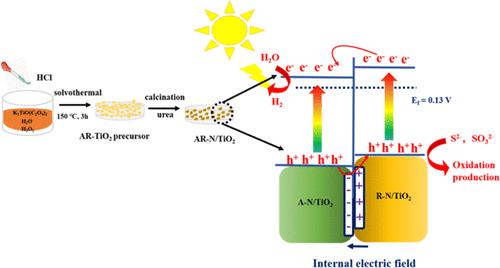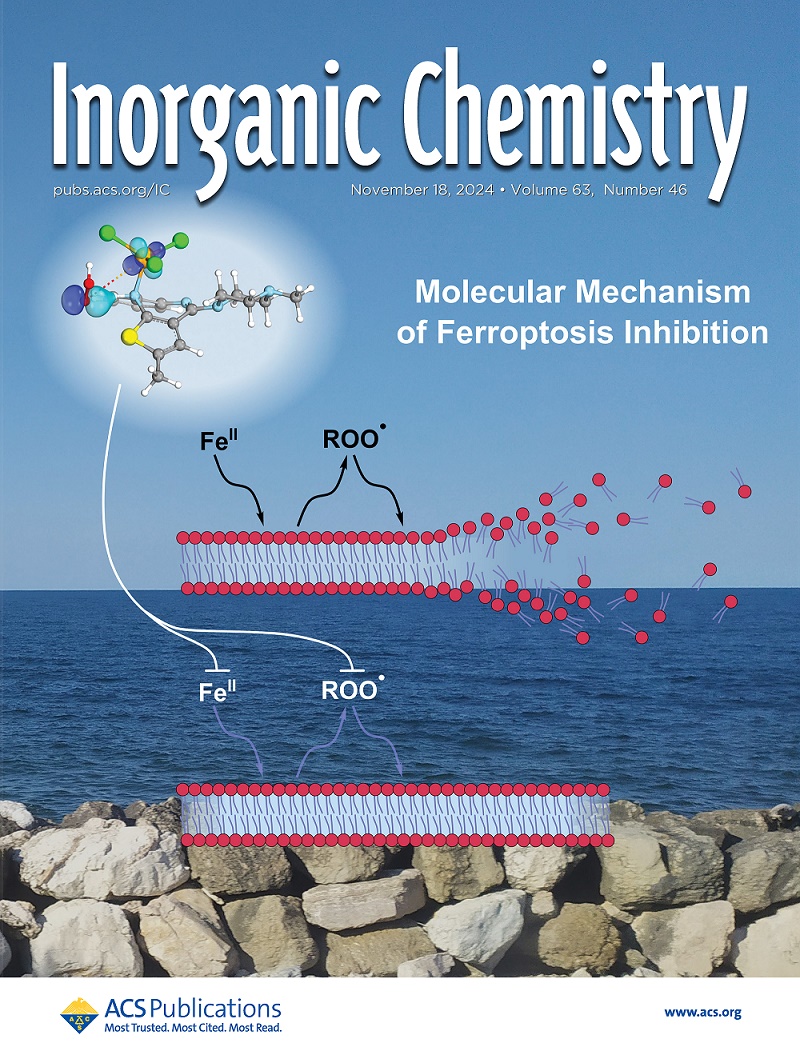通过原位相生长设计掺杂 N 的金红石/金红石 TiO2 异相结,用于光催化氢气转化
IF 4.3
2区 化学
Q1 CHEMISTRY, INORGANIC & NUCLEAR
引用次数: 0
摘要
通过结合掺杂 N 和原位异相结生成的策略,制备了掺杂 N 的锐钛矿/粗钛矿二氧化钛(AR-N/TiO2)光催化剂,显著提高了光催化 H2 生成量(1.68 mmol-h-1-g-1)。在 400 纳米的单色光下,其表观量子效率为 8.6%。此外,这种 AR-N/TiO2 异相结在可见光照射下表现出卓越的长期稳定性。通过对电子结构的分析,AR-N/TiO2 的出色光催化活性可归因于最佳金红石含量(21.6%)下金红石和锐钛矿之间协同效应的最大化,以及 N 掺杂导致的对可见光响应的增强。此外,金红石相从锐钛矿相的内核原位生长形成的亲密界面建立了排列整齐的带,促进了光诱导电子-空穴对的有效分离。此外,合成的异相结的粗糙表面和多孔性有利于扩大比表面积和暴露活性位点,从而提供更多的吸附和反应位点,提高转换效率。这项研究为开发基于二氧化钛的异相交界光催化剂提供了另一种相工程方法,以实现高效的氢气进化。本文章由计算机程序翻译,如有差异,请以英文原文为准。

Engineering of a N-Doped Anatase/Rutile TiO2 Heterophase Junction via In Situ Phase Growth for Photocatalytic Hydrogen Evolution
N-doped anatase/rutile TiO2 (AR-N/TiO2) photocatalysts were prepared by combining the strategy of N-doping and in situ heterophase junction generation, which significantly enhanced the photocatalytic H2 generation (1.68 mmol· h–1·g–1). Under monochromatic light at 400 nm, the light exhibits an apparent quantum efficiency of 8.6%. Moreover, this AR-N/TiO2 heterophase junction demonstrates excellent long-term stability when exposed to visible light irradiation. Through the analysis of the electronic structure, the outstanding photocatalytic activity of AR-N/TiO2 can be attributed to the maximized synergetic effect between rutile and anatase for optimal rutile content (21.6%) and enhanced response to visible light due to N-doping. Additionally, the intimate interface formed by the rutile phase grown in situ from the inner core of the anatase phase establishes well-aligned bands, which promote efficient separation of photoinduced electron–hole pairs. Furthermore, the rough surface and porosity of the as-synthesized heterophase junction facilitate an enlarged specific surface area and exposure of active sites, thereby providing more adsorptive and reactive sites that enhance conversion efficiency. This research offers an alternative approach to phase engineering for developing TiO2-based heterophase junction photocatalysts toward efficient hydrogen evolution.
求助全文
通过发布文献求助,成功后即可免费获取论文全文。
去求助
来源期刊

Inorganic Chemistry
化学-无机化学与核化学
CiteScore
7.60
自引率
13.00%
发文量
1960
审稿时长
1.9 months
期刊介绍:
Inorganic Chemistry publishes fundamental studies in all phases of inorganic chemistry. Coverage includes experimental and theoretical reports on quantitative studies of structure and thermodynamics, kinetics, mechanisms of inorganic reactions, bioinorganic chemistry, and relevant aspects of organometallic chemistry, solid-state phenomena, and chemical bonding theory. Emphasis is placed on the synthesis, structure, thermodynamics, reactivity, spectroscopy, and bonding properties of significant new and known compounds.
 求助内容:
求助内容: 应助结果提醒方式:
应助结果提醒方式:


